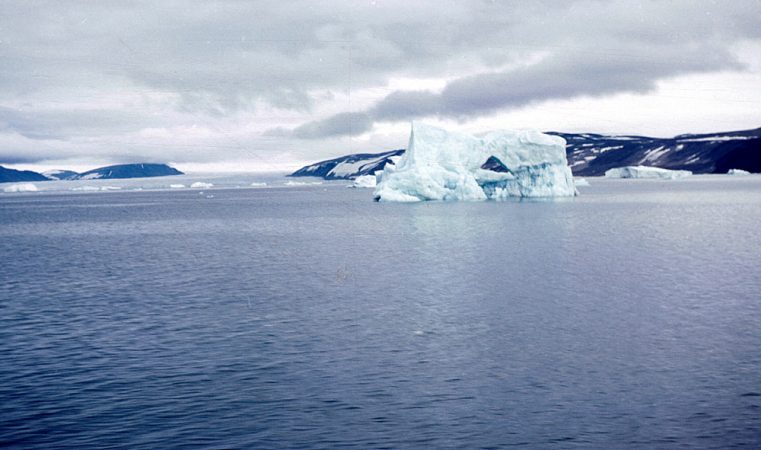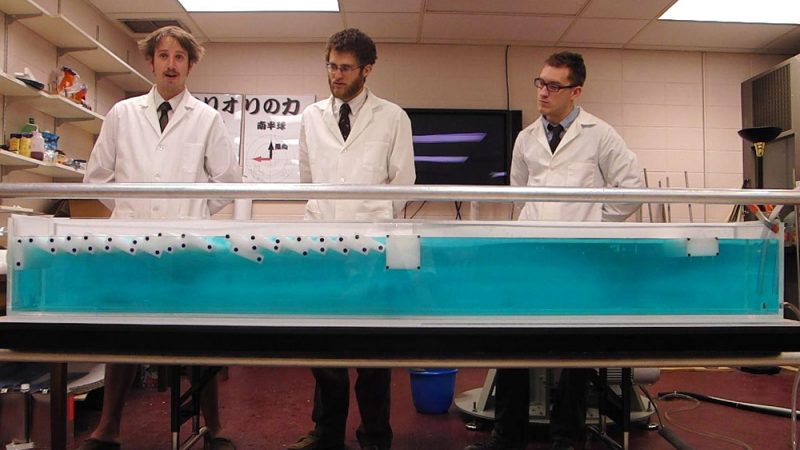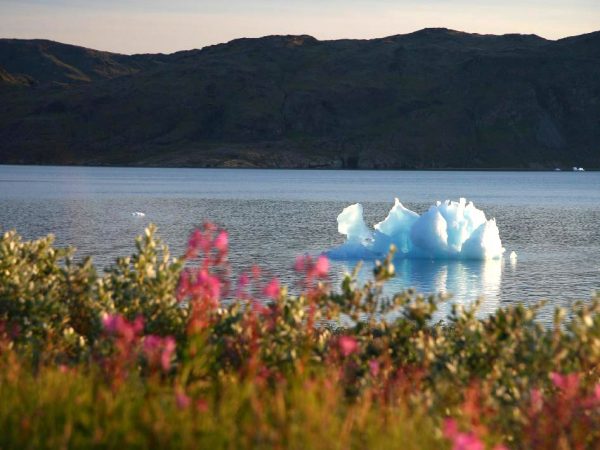Flipping icebergs
Capsizing icebergs may release as much energy as a bomb

Icebergs look like towering, frozen mountains that drift through water. Their peaks may soar hundreds of feet above the surface and large ones cover as much area as major cities. When one of these blocks of ice flips over, it causes a great splash. In recent experiments at the University of Chicago, scientists have calculated that an overturning iceberg may release as much energy as some of the most destructive events on the planet.
“It’s easily as much energy as an atomic bomb,” says physicist Justin Burton, who designed and carried out the experiments. He says an iceberg takes about three or four minutes to flip, and afterward it may send out large waves called tsunamis. Such a frozen flip may even trigger an earthquake. Burton and his colleagues published their results in the January 20 issue of the Journal of Geophysical Research.
In especially cold areas, like Greenland or Antarctica, glaciers may flow over the land and into the ocean. Where the edge of the glacier floats on water, it forms an ice shelf. An iceberg forms when part of the ice shelf cracks and breaks off. That’s when icebergs are most likely to capsize.
“Large icebergs break off glaciers and then they flip,” says Burton. If an iceberg flips close enough to the glacier or some other solid surface, it may shake the ground hard enough to be detected as an earthquake.

A model iceberg flips over and stirs the water in a water tank, allowing scientists to study what happens when icebergs turn over. Credit: Justin Burton
The force of gravity makes an iceberg flip. When an iceberg forms and plunges into the water, the block of ice may be unstable, or prone to move. A dropped ball is unstable and falls toward the ground; once it stops moving, it becomes stable. A balloon submerged in a pool of water is unstable and quickly floats to the surface. A person swishing down a waterslide is unstable and doesn’t stop moving until she reaches the bottom. In each of these cases, gravity causes an object to shift from instability to stability.
To understand how a glacier flips, imagine trying to float a rubber ducky on its head. No matter how many times you try, the ducky doesn’t stay put. Instead, the rest of its body falls into the water, too, and the upright ducky floats to the surface. Now imagine that an unstable iceberg is like a rubber ducky that weighs seven times as much as New York’s Brooklyn Bridge. The iceberg will twist in the water until it too finds a stable position, with most of its bulk at the bottom.
Icebergs don’t occur naturally in Chicago, so Burton and his colleagues had to find a clever way to study the ‘bergs behavior there. They built a model of an iceberg in their laboratory. They built a water tank that measured about 8 feet (244 centimeters) long, 11.8 inches (30 cm) wide and 11.8 inches tall. Burton says they initially wanted to use real ice to build their floating ‘bergs, but the ice melted too quickly. Instead, they used a type of plastic that had the same density as the ice in icebergs. Density is a measure of the mass — or stuff — within a certain amount of space. It determines whether or how something might float, and it’s calculated by dividing an object’s mass by its volume.
Burton’s team floated their plastic icebergs in the water tank, flipped them over, and then measured the waves.

Physicists already knew how to measure the energy released when gravity causes an unstable object to become stable. Burton and his colleagues used those same ideas to calculate the energy released by a flipping iceberg. Some of that energy is used to make the iceberg turn, but about 85 percent is simply released into the water.
The scientists found that a turning iceberg mixes up the water. If a warm, salty layer of water is initially floating on a cold, freshwater layer, for example, a flipping iceberg can mix those layers and change the overall temperature and chemical makeup of the water. The melting rates of glaciers may depend on the temperature of the water, so scientists are interested in figuring out how flipping icebergs might change those rates.
POWER WORDS (adapted from the New Oxford American Dictionary)
glacier A slowly moving mass or river of ice formed by the accumulation and compaction of snow on mountains or near the poles.
ice shelf A floating sheet of ice permanently attached to a landmass.
iceberg A large, floating mass of ice detached from a glacier or ice sheet and carried out to sea.
energy The capacity to perform work.
gravity The force that attracts a body toward the center of Earth, or toward any other physical body having mass.







